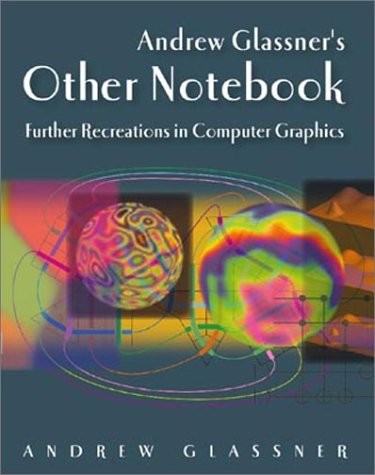|
Andrew
Glassner's Other Notebook
Author:
Andrew Glassner
Publisher: A.K. Peters Ltd
ISBN: 1-56881-171-3
Purchasing: [Amazon.Com]
- RRP US$45.00
Reviewed: 8th September 2002
Front
Cover Shot:

Overview
This
book is, as the sub-title suggests, a 'recreation'
book - it's for those computer-graphics
enthusiasts who want to read around their subject.
It's the kind of book that can teach you a lot
without actually intending to - it's not aimed at
a particular computer system, programming language
or hardware configuration or even a particular
area of computer graphics.
This
is the sort of book you'll read through and it may
give you that alternative way of looking at
certain types of problems or giving you a couple
of new avenues to explore that you hadn't
considered before.
Re-Printed,
only better.
Andrew
Glassner is a veteran of the computer graphics
industry, he's been around for quite a while and
got quite a good reputation for himself.
Almost
all of the content in this short book (252 pages)
has already been published under 'Andrew
Glassner's Notebook' in the magazine IEEE
Computer Graphics & Applications - the
major differences is that each chapter has been
put together better and with comments and errata
included. 'Notes' that might have spanned 3 issues
of the magazine have been put together as one
chapter, with no obvious breaks.
For
those of you familiar with the IEEE Computer
Graphics & Applications magazine (the
first time I'd heard of it was when reading this
book) the chapters are based on his columns
published between May 1999 and November 2001. If
you happen to read the magazine and have kept them
somewhere then you'll be able to find the majority
of the work presented in this book already - apart
from one bonus chapter on shape synthesizers.
Not
for the feint-hearted
This
book is strictly a fun book, for your
reading enjoyment only (as opposed to searching
for, and learning, technical information). But
that doesn't mean it has to be light reading -
some of the topics here, and the depth Andrew
Glassner goes to makes for quite complex reading.
A good example is the chapter on Quantum Computers
- admittedly, by it's very nature is a weird and
complicated subject, but try to read it at anytime
of day (especially at 3:30am, when I got home from
work) and you'd really better be paying attention.
For this reason, the collected works presented
here sustain more reading than you might expect .
The
chapter on Quantum Computing is quite a bit more
dense and hard to read than the rest of the book,
but to follow Glassner's musing it is necessary to
get your head around the logic/theory used.
However, chances are that if you're a computer
graphics enthusiast you'll be more than qualified
to keep up!
But
still an entertaining and easy read
The
book, as Glassner puts it in the first sentence of
the preface: "This book is about having fun
with computer graphics". This statement
remains true for the majority of the book,
obviously some parts will appeal more to other
people, but in general if you find something that
grabs your attention it is a pleasure to read
through it. I personally liked the chapters on
Celtic knot-work and soap bubbles.
The
writing style used is generally informal (except
when it's necessary to explain things with
mathematics) and is very much in the style of the
author writing how he might talk to you about this
subject.
The
other great thing about this book is the way it's
presented on each page - every page is adorned
with lots of colorful diagrams and photos - not
something you usually find with computer books,
the best you can usually hope for is a set of
color plates in the middle of the book. This very
visual approach to presenting his notes emphasizes
the informal and friendly writing style.
In
Conclusion
On
the face of things, this book doesn't set out to
teach you an area of computer graphics, like the
majority of related books do. Instead it will
teach you by presenting new ideas and thoughts on
existing ones - a completely subtle way of
learning. Alternatively, you can read this book
with no intention of learning any particular
skills and just enjoy reading about some of the
more obscure and interesting areas of the computer
graphics field.
| Good
Things |
Bad
Things |
| •
A different book to that usually published
about the computer graphics field |
•
Much of the content has already been
published. |
| •
Informative text with an easy to read
writing style. |
•
Can make for particularly dense and
complex reading |
| •
Can give you new ways of looking at common
problems. |
•
A little bit expensive despite all the
improvements, its mostly old-material re-
printed. |
| •
Sustains more reading than most books.
given its size |
|
| •
Excellent presentation, the colorful
layout makes it much more enjoyable to
read. |
|
|

